Updated, Sept. 28: The court hearing scheduled for today was delayed again by a judge, effectively delaying any tree removal until at least next spring. A judge delayed hearing arguments on Friends of the White River's petition until some time in January.
Original story:
INDIANAPOLIS -- Debate over how to finish a flood barrier for Northside residents has stretched on for more than a decade. But now a new step toward that process is drawing its own lengthy debate.
From the top of an earthen levee, the White River below looks calm. The wall is to protect the neighborhood on the other side from this river if it floods its banks. But fifteen years after work on building the levee first began, it’s not completed.
And so Warfleigh neighborhood residents like Jim Polito are still paying high premiums for flood insurance. "Lives remain at risk; we’re subject to the precipitous increases in flood insurance. And it’s just a waste of millions and millions of construction dollars," he said.
While the levee follows the river from near Broad Ripple through Polito’s neighborhood, it isn’t completed at the other end. It’s not tied into high ground, which would stop the water from simply flowing around it if there was a flood. There are a few alternatives on where and how to do that, but nothing has been agreed on.
While that process lags on, another debate has emerged. The Army Corps of Engineers has been upgrading its requirements for a levee’s strength before flood maps can be redrawn. Now it says trees growing on or too close to the levee need to be cut down in order to improve its structural resilience.
"The vegetation needs to be removed in order for a levee to meet the criteria of the Army Corps of Engineers," said Carol Labashosky, a spokeswoman for the Corps.
And why’s that?
"Because they present safety concerns, according to the Corp of Engineers," said Polito. "And if these trees aren’t cut down, I mean, imagine a big tree – a hundred-year-old tree falling, what uprooting of the roots would do to an earthen levee."
Cutting down those trees would help the levee reach at least partial certification, even though it’s not technically complete. But the plan concerns environmentalists, who say that felling that many trees will damage an important urban ecosystem.
"We’re not convinced trees pose a threat to the levee," said Kevin Hardie, executive director of the Friends of the White River. His group wants the trees to stay.
Standing on its banks, Hardie points out the habitat that this snaking river and its banks provide "for fish, for birds, there are mink, there are fox, there are dear. And it’s an area that people use for recreation and they’re unaware, for the most part, the extent of this project."
Friends of the White River has asked local officials to delay issuing the permit for tree removal so they can present their arguments.
The whole project frustrates Warfleigh resident Jeff Bates. He accuses influential residents and institutions down river of stalling the project while his and other’s insurance rates continue to rise.
"Complete the wall, as quickly as you can, to protect all these homes and a couple thousand people north of that area. Then, take your time, figure out how you want to protect the canal," he said.
Labashosky, with the Corps of Engineers, says that will happen, eventually. "It’s one of these cases where, slow and steady wins the race because, ultimately, the plan is to finish the levee," she said.
A meeting is scheduled for later this month with the state Department of Natural Resources and city officials over the Friends of the White River’s challenge to the tree removal. Analysis on the different options for completing the levee is ongoing.
CORRECTION: The original print and broadcast version of this story had the wrong last name for Jeff Bates.
 DONATE
DONATE






 View More Articles
View More Articles





 Support WFYI. We can't do it without you.
Support WFYI. We can't do it without you.